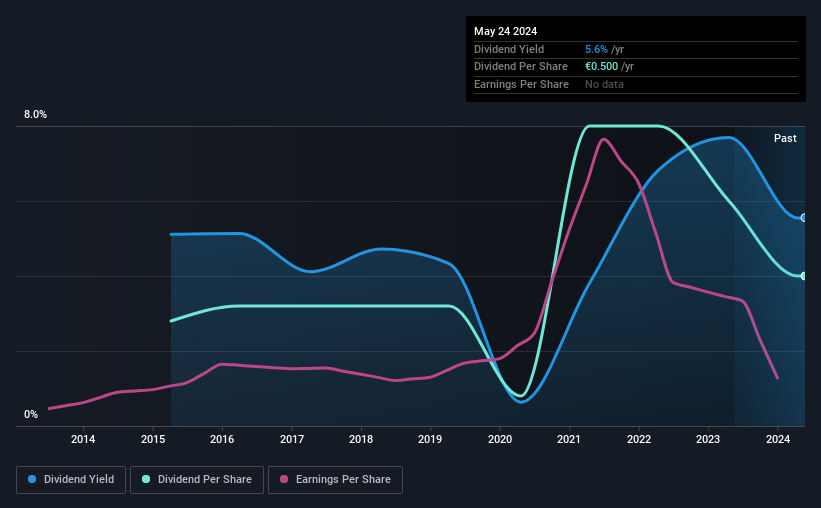We Wouldn't Be Too Quick To Buy DocCheck AG (ETR:AJ91) Before It Goes Ex-Dividend
DocCheck AG (ETR:AJ91) stock is about to trade ex-dividend in 4 days. Typically, the ex-dividend date is one business day before the record date which is the date on which a company determines the shareholders eligible to receive a dividend. The ex-dividend date is of consequence because whenever a stock is bought or sold, the trade takes at least two business day to settle. Accordingly, DocCheck investors that purchase the stock on or after the 30th of May will not receive the dividend, which will be paid on the 3rd of June.
The company's next dividend payment will be €0.50 per share, on the back of last year when the company paid a total of €0.50 to shareholders. Based on the last year's worth of payments, DocCheck has a trailing yield of 5.6% on the current stock price of €9.00. Dividends are a major contributor to investment returns for long term holders, but only if the dividend continues to be paid. That's why we should always check whether the dividend payments appear sustainable, and if the company is growing.
View our latest analysis for DocCheck
Dividends are typically paid out of company income, so if a company pays out more than it earned, its dividend is usually at a higher risk of being cut. DocCheck paid out 112% of profit in the past year, which we think is typically not sustainable unless there are mitigating characteristics such as unusually strong cash flow or a large cash balance. Yet cash flow is typically more important than profit for assessing dividend sustainability, so we should always check if the company generated enough cash to afford its dividend. Dividends consumed 67% of the company's free cash flow last year, which is within a normal range for most dividend-paying organisations.
It's disappointing to see that the dividend was not covered by profits, but cash is more important from a dividend sustainability perspective, and DocCheck fortunately did generate enough cash to fund its dividend. If executives were to continue paying more in dividends than the company reported in profits, we'd view this as a warning sign. Extraordinarily few companies are capable of persistently paying a dividend that is greater than their profits.
Click here to see how much of its profit DocCheck paid out over the last 12 months.
Have Earnings And Dividends Been Growing?
Companies that aren't growing their earnings can still be valuable, but it is even more important to assess the sustainability of the dividend if it looks like the company will struggle to grow. If earnings decline and the company is forced to cut its dividend, investors could watch the value of their investment go up in smoke. It's not encouraging to see that DocCheck's earnings are effectively flat over the past five years. We'd take that over an earnings decline any day, but in the long run, the best dividend stocks all grow their earnings per share.
Another key way to measure a company's dividend prospects is by measuring its historical rate of dividend growth. DocCheck has delivered an average of 4.0% per year annual increase in its dividend, based on the past nine years of dividend payments.
Final Takeaway
Should investors buy DocCheck for the upcoming dividend? Earnings per share have been flat in recent times, which is, we suppose, better than seeing them shrink. Plus, DocCheck's paying out a high percentage of its earnings and more than half its cash flow. It's not the most attractive proposition from a dividend perspective, and we'd probably give this one a miss for now.
So if you're still interested in DocCheck despite it's poor dividend qualities, you should be well informed on some of the risks facing this stock. Our analysis shows 3 warning signs for DocCheck and you should be aware of them before buying any shares.
Generally, we wouldn't recommend just buying the first dividend stock you see. Here's a curated list of interesting stocks that are strong dividend payers.
Have feedback on this article? Concerned about the content? Get in touch with us directly. Alternatively, email editorial-team (at) simplywallst.com.
This article by Simply Wall St is general in nature. We provide commentary based on historical data and analyst forecasts only using an unbiased methodology and our articles are not intended to be financial advice. It does not constitute a recommendation to buy or sell any stock, and does not take account of your objectives, or your financial situation. We aim to bring you long-term focused analysis driven by fundamental data. Note that our analysis may not factor in the latest price-sensitive company announcements or qualitative material. Simply Wall St has no position in any stocks mentioned.

 雅虎香港財經
雅虎香港財經 
